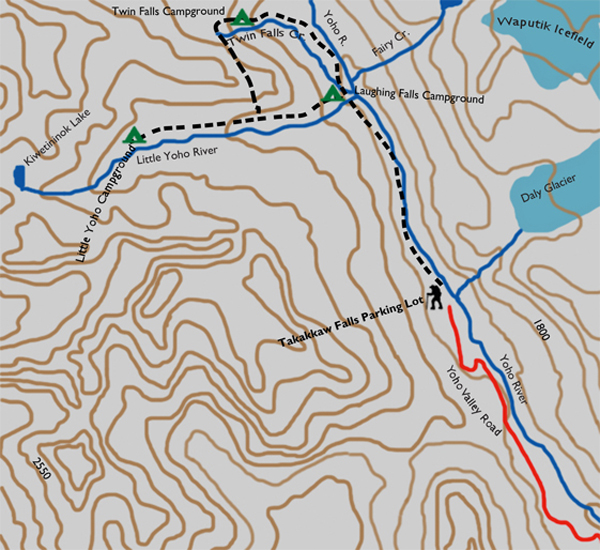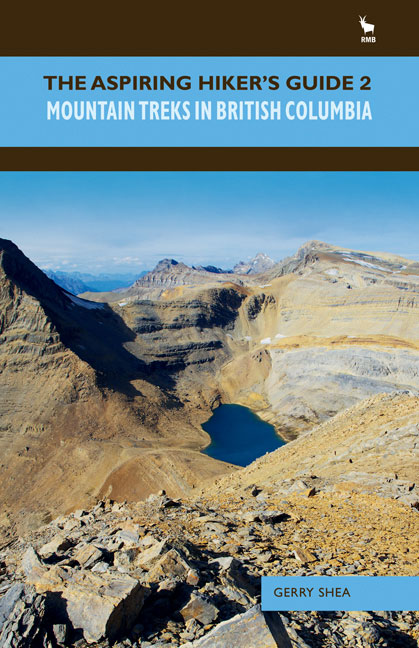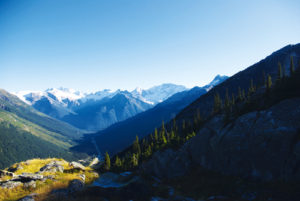Distance
As the path levels off, the short, 400-m side trail leading to Lake Duchesnay is marked, but the trip in actually seems much shorter than the 400 m indicated by the Parks Canada sign. The lake starts to dry up by late June and is often completely dry by late August. Don’t let your sense of adventure get carried away here, as the mud can often be knee-deep. From this intersection, the level path crosses the Little Yoho River and enters Laughing Falls Campground just a few short minutes later.
Laughing Falls Campground is located on an alluvial fan. Campers in this forest clearing enjoy a spectacular view of Yoho Glacier to the north and the Waputik Range to the east. Three streams intersect at the campground: the Yoho and Little Yoho rivers and Twin Falls Creek. The source of the Yoho River and Twin Falls Creek is the massive Wapta Icefield, while the Little Yoho derives its energy from Kiwetinok Lake. There are tent pads along the banks of these streams for those campers who like to drift off to sleep to the sound of rushing water. To reach the captivating and accessible Laughing Falls, cross the bridge that leads to the campground, stay left and follow the well-beaten path to the viewpoint.
The best day excursion from Laughing Falls Campground is the rustic Twin Falls Teahouse, 4.3 km farther up the trail. The first phase of the teahouse was constructed by the Canadian Pacific Railway in 1908 as a single-storey cabin for overnight backcountry touring. An additional storey was finished in 1924, adding room for more guests. Simple meals and beverages are offered throughout the summer. The teahouse derives its name from the extraordinary Twin Falls situated at this remarkable landscape. The top of the waterfall is split in two by a large limestone block, after which the two cascades merge into one as the water plummets 180 m into a narrow gorge.
Yoho history
James Hector was the first non-Native explorer to reach these lands, in 1858. He departed Old Bow Fort on August 11 of that year to explore the Bow Valley and search for the source of the Bow River. After initially coming to this region of beauty as a member of the Palliser Expedition, Hector had expanded his exploration and would end up seeking a trading route to the Columbia River. He was guided by a Stoney Indian, Nimrod, who had a rough map of the route he had decided Hector should take as he left Old Bow Fort. The map, incidentally, put Hector and his crew on an indirect course that had them finally coming out of Vermilion Pass. During the exploration into the Kootenai area, Hector discovered the Kicking Horse River.
It would be some years before the Kicking Horse/Yoho area began to see more visitors. The town of Field was established in 1880, resulting from an influx of CPR construction workers. The townsite of tents and shacks became a hub of activity and soon small outbuildings began to crop up, including hotels, guide houses and chalets. Hiking trails were also constructed, to entice tourists as well as investors and help ensure economic success for the new enterprise. Many of the routes still used today were constructed during this time. The railway was completed in 1885, and to further stimulate tourism to this gorgeous place the CPR introduced Swiss guides to escort amateur mountaineers to the surrounding summits.
The CPR’s marketing efforts were successful, and to accommodate the resulting influx of tourists the company progressively constructed an ensemble of lodges in the present-day Yoho area. Facilities were completed at Emerald Lake, Lake O’Hara, Wapta Lake and in the Yoho Valley. The pride of these lodges was Mount Stephen House, completed in 1886. It was initially built as a dining hall so that trains did not have to haul heavy diner-cars up the steep grade to Field. Converted to a YMCA hostel during the First World War, Mount Stephen House never regained its former glory, and by 1963 it had been dismantled.
The Yoho Valley was finally explored in 1896/97 by a mathematics professor from Berlin, Jean Habel, who had climbed extensively in the Andes and the Alps. Habel was the first to discover the headwaters of the Athabasca River. Habel Creek in Jasper National Park is named after him. He also claimed to have discovered Takakkaw Falls, Yoho Pass, Emerald Lake and the Yoho Glacier, though the noted guide, outfitter and prospector Tom Wilson later attempted to discredit those claims at least in part, asserting that it was he and not Habel who had discovered Emerald Lake and Yoho Pass.
Directions
After you obtain a wilderness pass from the Yoho Information Centre in Field, BC, drive 3.7 km east on the Trans-Canada Highway and turn left onto Yoho Valley Road. Follow this road for 13 km to the Takakkaw Falls parking area. The Yoho Valley Trail starts at the far end of the parking lot. Almost immediately after the hike begins, you will reach Takakkaw Falls Campground, barely 400 m from the parking lot. Through the campground, at its far end, is the Yoho Valley trailhead.


Gerry Shea
“Gerry Shea moved to Kamloops from Vancouver at the age of nine, which is when he became enchanted by the nearby hills. It was on a family vacation many years later that he discovered the mountains and began hiking and climbing in his spare time, gathering knowledge and experience that he has since used to help beginning hikers, scramblers and backpackers to trek safely. Gerry lives in Kamloops with his wife and children.”Excerpt From: Gerry Shea. “The Aspiring Hiker’s Guide 2: Mountain Treks in British Columbia.” iBooks.




